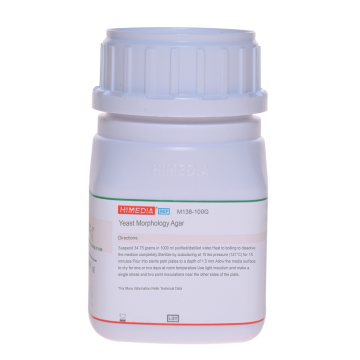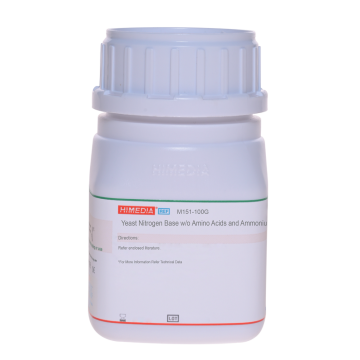 Your enquiry has been submitted
Your enquiry has been submitted
Yeast Carbon Base
Yeast Carbon Base is recommended for use in the classification of yeasts on the basis of their ability to assimilate nitrogen compounds.
Composition**
| Ingredients | Gms/Litre |
|---|---|
| Dextrose | 10.000 |
| L-Histidine hydrochloride | 0.001 |
| DL-Methionine | 0.002 |
| DL-Tryptophan | 0.002 |
| Biotin | 0.000002 |
| Calcium pantothenate | 0.0004 |
| Folic acid | 0.000002 |
| Inositol | 0.002 |
| Niacin | 0.0004 |
| p-Amino benzoic acid (PABA) | 0.0002 |
| Pyridoxine hydrochloride | 0.0004 |
| Riboflavin (Vitamin B2) | 0.0002 |
| Thiamine hydrochloride | 0.0004 |
| Boric acid | 0.0005 |
| Copper sulphate | 0.00004 |
| Potassium iodide | 0.0001 |
| Ferric chloride | 0.0002 |
| Manganese sulphate | 0.0004 |
| Sodium molybdate | 0.0002 |
| Zinc sulphate | 0.0004 |
| Monopotassium phosphate | 1.000 |
| Magnesium sulphate | 0.500 |
| Sodium chloride | 0.100 |
| Calcium chloride | 0.100 |
Final pH (at 25°C): 5.5±0.2
**Formula adjusted, standardized to suit performance parameters
Directions
- For Nitrogen Assimilation test, prepare the broth base in 10X concentration. Dissolve 11.71 grams in 100 ml distilled water. Add sterile nitrogen source as desired to it. Warm if necessary to dissolve the medium completely. Sterilize by filtration.
- For detection of yeasts, other than Saccharomyces cerevisiae, dissolve 2.35 grams of Yeast Carbon Base in 100 ml distilled water.
- For detection and enumeration of wild yeasts in beer and other brewing materials add 0.33 grams of Ammonium sulphate and 4 grams of agar to Base prepared as per B. Sterilize by autoclaving at 15 lbs pressure (121°C) for 15 minutes.
Principle And Interpretation
Yeasts are unicellular fungi. They are easily differentiated from most bacteria because of their relatively larger size and morphological features. Yeasts are used for synthesizing certain fats, vitamins and proteins from simple sugars and ammonium nitrogen. They are also known to cause plant and animal diseases, spoil food and bring about deterioration of textiles and other materials (1). Yeast Carbon Base, developed by Wickerham (2-5), is used for the classification of yeasts on the basis of their ability to assimilate various nitrogen compounds. The nitrogen assimilation ability is tested by adding various nitrogen sources such as ammonium sulphate (1 gm), urea (0.46 gm), potassium nitrate (0.78 gm), asparagine (1 gm), peptone (gelatin 1.32 gm).
Yeast Carbon Base is composed of a defined set of nutrients including carbon source, amino acids, vitamins and minerals required for the growth of yeasts. The inclusion of vitamins in this base was found necessary by Wickerham as an aid for utilization of nitrogen compounds by certain yeasts as they cannot assimilate these compounds in the absence of vitamins.
Quality Control
Appearance White to cream homogeneous free flowing powder
Colour and Clarity of prepared medium colourless clear solution without any precipitate.
Reaction Reaction of 1.17% w/v aqueous solution at 25°C. pH : 5.5±0.2
pH 5.30-5.70
Cultural Response M141: Cultural characteristics observed after an incubation at 25-30°C for 6-7 days or longer if required
| Organism | Inoculum (CFU) | Growth (Plain) | Growth (with Ammonium sulphate) |
|---|---|---|---|
| Saccharomyces cerevisiae ATCC 9763 | 50-100 | none-poor | good |
| Saccharomyces uvarum ATCC 28098 | 50-100 | none-poor | good |
Storage and Shelf Life
Store dehydrated powder and prepared medium at 2-8°C in tightly closed container. Use before expiry period on the label.
Reference
- Pelczar M. J. Jr., Reid R. D., Chan E. C. S., 1977, Microbiology, 4th Ed., Tata McGraw-Hill Publishing Company Ltd., New Delhi.
- Wickerham L. J., 1951, U.S. Dept. Agric. Tech. Bull. No. 1029.
- Wickerham L. J., 1939, J. Tropical Med. Hyg. 42:176
- Wickerham L. J., 1948, J. Bacteriol., 56:363.
- Wickerham L. J., 1943, J. Bacteriol., 46:501.
| Product Name | Yeast Carbon Base |
|---|---|
| SKU | M141 |
| Product Type | Regular |
| Physical Form | Powder |
| Origin | Chemically defined (HiCynth™) |
| Packaging type | HDPE |
| References | 1. Pelczar M. J. Jr., Reid R. D., Chan E. C. S., 1977, Microbiology, 4th Ed., Tata McGraw-Hill Publishing Company Ltd.,New Delhi. 2.Wickerham L. J., 1951, U.S. Dept. Agric. Tech. Bull. No. 1029. 3.Wickerham L. J., 1939, J. Tropical Med. Hyg. 42:176 4.Wickerham L. J., 1948, J. Bacteriol., 56:363. 5.Wickerham L. J., 1943, J. Bacteriol., 46:501. |
| Customized Product Available | No |








